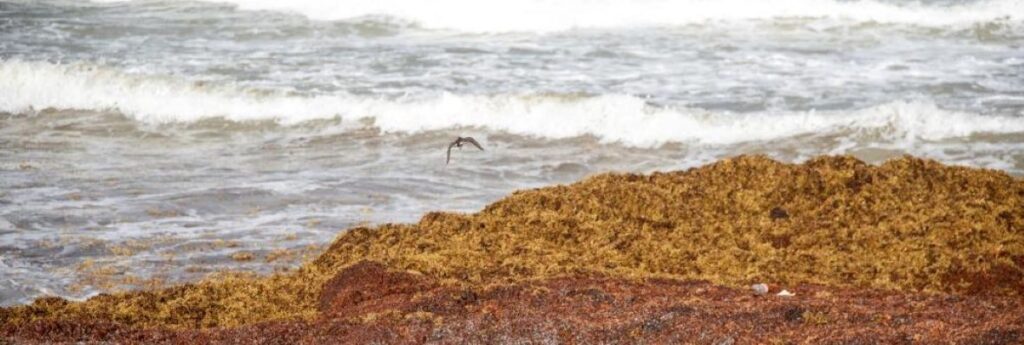A record amount of seaweed is smothering Caribbean coasts from Puerto Rico to Barbados as tons of brown algae kill wildlife, choke the tourism industry and release toxic gases.
More than 24 million tons of sargassum blanketed the Atlantic in June, up from 18.8 million tons in May, according to a monthly report published by the University of South Florida’s Optical Oceanography Lab that noted “a new historical record.”
July saw no decrease of algae in the Caribbean Sea, said Chuanmin Hu, an optical oceanography professor who helps produce the reports.
“I was scared,” he recalled feeling when he saw the historic number for June. He noted it was 20% higher than the previous record set in May 2018.
Additional data complied by Hu showed sargassum levels for the eastern Caribbean at a near record high this year, second only to those reported in July 2018. Levels in the northern Caribbean are at their third highest, following July 2018 and July 2021, he said.
Scientists say more research is needed to determine why sargassum levels in the region are reaching new highs, but the United Nations’ Caribbean Environment Program says possible factors include a rise in water temperatures as a result of climate change and nitrogen-laden fertilizers and sewage waste fuelling algae blooms.
“This year has been the worst year on record,” said Lisa Krimsky, a researcher and faculty member with Florida Sea Grant and a water resources regional specialized agent at University of Florida. “It is absolutely devastating for the region.”
She said large masses of seaweed have a severe environmental impact, with decaying algae altering water temperatures and the pH balance as well as leading to declines in seagrass, coral reef, and sponge populations.
“They’re essentially being smothered out,” Krimsky said.
The “golden tide” also has hit humans hard.
The concentration of algae is so heavy in some parts of the eastern Caribbean that the French island of Guadeloupe issued a health alert in late July. It warned some communities about high levels of hydrogen sulfide emanating from huge rotting clumps of seaweed, which can affect people with respiratory problems including asthma.
A federal emergency was declared after the US Virgin Islands warned last month of “unusually high amounts” of sargassum affecting water production at a desalination plant near St. Croix that is struggling to meet demand amid a drought.
Experts first noted large amounts of sargassum in the Caribbean Sea in 2011 that Hu and other scientists think were created by stronger than normal winds and currents. The problem has worsened as clumps multiplied, fuelled by nutrients and strong sunlight.
“In the tropical Atlantic, everything was right,” Hu said. “Everything grows fast.”
Sargassum in moderation helps purify water, absorb carbon dioxide and is a key habitat for fish, turtles, shrimp, crabs, and other creatures. But it is bad for tourism, the economy, and the environment when too much accumulates just offshore or on beaches.
A carpet of brown algae recently surrounded an uninhabited island near the French Caribbean territory of St. Martin that is popular with tourists, forcing officials to suspend ferry service and cancel kayaking and snorkeling tours. The normally translucent waters around Pinel Island turned into a prickly brown slush.
“This is the worst we’ve ever seen it for sure,” said Melody Rouveure, general manager for a tour company in the Dutch Caribbean territory of St. Maarten, which shares an island with St. Martin. “It did ruin my personal beach plans.”
On Union Island, which is part of St. Vincent and the Grenadines, the seaweed invasion has forced some resorts to close for up to five months in the past.
Masses of sargassum also have strangled the Caribbean’s fishing industry. It damages boat engines and fishing gear, prevents fishermen from reaching their boats and fishing areas and leads to a drop in the number of fish caught. Barbados has been especially hit hard since flying fish make up 60% of the island’s annual landed catch, according to the University of the West Indies.
In the Cayman Islands, a thick carpet of sargassum had prompted officials to launch a trial program in which crews pumped more than 268 sq. m. of seaweed out of the water. But on Tuesday, the government announced it suspended removal efforts because the level of decomposition made it impractical.
Since 2011, large amounts of sargassum have invaded the Caribbean every year except 2013 — an anomaly that scientists believe may have resulted from a lack of nutrients and a change in wind strength and direction. And the record amounts reported in recent years are even more concerning for scientists and island governments.
“We don’t know if this is a new normal,” Krimsky said. “This has been devastating for over a decade.”

